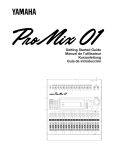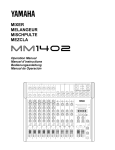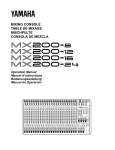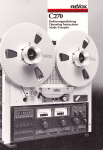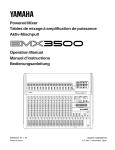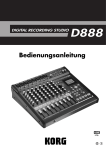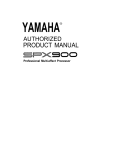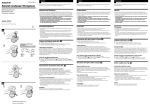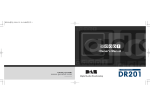Download Yamaha MM1242 Specifications
Transcript
MIXER MELANGEUR MISCHPULTE MEZCLA Operation Manual Manuel d’instructions Bedienungsanleitung Manual de Operación GAIN GAIN GAIN GAIN GAIN GAIN GAIN GAIN GAIN GAIN GAIN GAIN MIXER +10 –16 –60 –26 LINE MIC +10 –16 –60 –26 LINE MIC HIGH +15 –12 LOMID –12 +15 –12 LOMID +12 –12 LOW –15 +15 +12 –12 +15 10 0 AUX 3 10 0 AUX 4 10 0 PAN 10 –12 10 0 AUX 3 10 P 0 R E AUX 4 10 –12 10 0 AUX 3 10 P 0 R E AUX 4 10 –12 10 0 AUX 3 10 P 0 R E AUX 4 10 –12 10 0 AUX 3 10 P 0 R E AUX 4 10 –12 10 0 AUX 3 10 P 0 R E AUX 4 10 –12 10 0 AUX 3 10 P 0 R E AUX 4 10 –12 10 0 AUX 3 10 P 0 R E AUX 4 10 10 0 AUX 3 10 P 0 R E AUX 4 10 –12 10 0 AUX 3 10 P 0 R E AUX 4 10 +15 10 0 AUX 3 10 +2 0 0 –2 –2 –7 –10 –15 –15 L R PEAK L PFL 1 10 0 PAN R PEAK L PFL 10 0 PAN R PEAK L PFL 10 0 PAN R PEAK L PFL 10 0 PAN R PEAK L PFL 10 0 PAN R PEAK L PFL 10 0 PAN R PEAK L PFL 10 0 PAN R PEAK L PFL 10 0 PAN R PEAK L PFL 10 0 PAN 10 0 AUX 3 10 P 0 R E AUX 4 R PEAK L PFL 10 10 0 PAN R PEAK –20 AUX 3 R AUX SEND 1 P R E L 10 R PEAK PFL PFL OFF AUX 4 PHONES OUTPUT LEVEL P O S T 0 10 0 10 AUX SEND 2 0 10 0 10 L 0 PAN ON –4 –7 –10 L P 0 O S AUX T 2 10 P 0 R E AUX 4 +4 +2 –20 AUX 1 P 0 O S AUX T 2 +6 +4 –4 +12 –15 AUX 1 P 0 O S AUX T 2 +6 +12 LOW +15 POWER POWER +15 –12 LOMID +12 –15 AUX 1 P 0 O S AUX T 2 +12 –12 PHANTOM –15 HIMID LOW +15 –60 –26 HIGH +15 –12 LOMID +12 –15 AUX 1 P 0 O S AUX T 2 +12 +10 –16 LINE MIC –15 HIMID LOW +15 –60 –26 HIGH +15 –12 LOMID +12 –15 AUX 1 P 0 O S AUX T 2 +12 +10 –16 LINE MIC –15 HIMID LOW +15 –60 –26 HIGH +15 –12 LOMID +12 –15 AUX 1 P 0 O S AUX T 2 +12 +10 –16 LINE MIC –15 HIMID LOW +15 –60 –26 HIGH +15 –12 LOMID +12 –15 AUX 1 P 0 O S AUX T 2 +12 +10 –16 LINE MIC –15 HIMID LOW +15 –60 –26 HIGH +15 –12 LOMID +12 –15 AUX 1 P 0 O S AUX T 2 +12 +10 –16 LINE MIC –15 HIMID LOW +15 –60 –26 HIGH +15 –12 LOMID +12 –15 AUX 1 P 0 O S AUX T 2 +12 +10 –16 LINE MIC –15 HIMID LOW +15 –60 –26 HIGH +15 –12 LOMID +12 –15 AUX 1 P 0 O S AUX T 2 +12 +10 –16 LINE MIC –15 HIMID LOW +15 –60 –26 HIGH +15 –12 LOMID +12 –15 AUX 1 0 AUX 2 +12 +10 –16 LINE MIC –15 HIMID LOW –15 AUX 1 +15 –12 LOMID LOW –60 –26 HIGH –15 HIMID +12 +10 –16 LINE MIC HIGH –15 HIMID +12 –60 –26 LINE MIC HIGH –15 HIMID +10 –16 MONITOR 0 10 0 10 L LEVEL 0 10 0 10 L L R R R R 0 10 AUX RETURN 1 0 10 AUX RETURN 2 0 10 AUX RETURN 3 0 10 AUX RETURN 4 PFL PFL PFL PFL 10 10 10 10 10 10 10 10 10 10 10 10 10 10 10 10 5 0 5 0 5 0 5 0 5 0 5 0 5 0 5 0 5 0 5 0 5 0 5 0 5 0 5 0 5 0 5 0 5 5 5 5 5 5 5 5 5 5 5 5 5 5 5 5 10 10 10 10 10 10 10 10 10 10 10 10 10 10 10 10 15 20 15 20 15 20 15 20 15 20 15 20 15 20 15 20 15 20 15 20 15 20 15 20 15 20 15 20 15 20 15 20 30 30 30 30 30 30 30 30 30 30 30 30 30 30 30 30 40 40 40 40 40 40 40 40 40 40 40 40 40 40 40 40 00 00 00 00 00 00 00 00 00 00 00 00 00 00 00 2 3 4 5 6 7 8 9 10 11 12 L ST R 3 AUX SEND 00 4 FCC INFORMATION (U.S.A.) 1. IMPORTANT NOTICE: DO NOT MODIFY THIS UNIT! This product, when installed as indicated in the instructions contained in this manual, meets FCC requirements. Modifications not expressly approved by Yamaha may void your authority, granted by the FCC, to use the product. 2. IMPORTANT: When connecting this product to accessories and/or another product use only high quality shielded cables. Cable/s supplied with this product MUST be used. Follow all installation instructions. Failure to follow instructions could void your FCC authorization to use this product in the USA. 3. NOTE: This product has been tested and found to comply with the requirements listed in FCC Regulations, Part 15 for Class “B” digital devices. Compliance with these requirements provides a reasonable level of assurance that your use of this product in a residential environment will not result in harmful interference with other electronic devices. This equipment generates/uses radio frequencies and, if not installed and used according to the instructions found in the users manual, may cause interference harmful to the operation of other electronic devices. Compliance with FCC regulations does not guarantee that interference will not occur in all installations. If this product is found to be the source of interference, which can be determined by turning the unit “OFF” and “ON”, please try to eliminate the problem by using one of the following measures: Relocate either this product or the device that is being affected by the interference Utilize power outlets that are on different branch (circuit breaker of fuse) circuits or install AC line filter/s. In the case of radio or TV interference, relocate/reorient the antenna. If the antenna lead-in is 300 ohm ribbon lead, change the lead-in to coaxial type cable. If these corrective measures do not produce satisfactory results, please contact the local retailer authorized to distribute this type of product. If you can not locate the appropriate retailer, please contact Yamaha Corporation of America. Electronic Service Division, 6600 Orangethorpe Ave, Buena Park, CA 90620 * This applies only to products distributed by YAMAHA CORPORATION OF AMERICA CANADA Dette apparat overholder det gaeldende EF-direktiv vedtrørende radiostøj. THIS DIGITAL APPARATUS DOES NOT EXCEED THE “CLASS B” LIMITS FOR RADIO NOISE EMISSIONS FROM DIGITAL APPARATUS SET OUT IN THE RADIO INTERFERENCE REGULATION OF THE CANADIAN DEPARTMENT OF COMMUNICATIONS. Cet appareil est conforme aux prescriptions de la directive communautaire 87/308/CEE. Diese Geräte entsprechen der EG-Richtlinie 82/499/EWG und/ oder 87/308/EWG. LE PRESENT APPAREIL NUMERIQUE N’EMET PAS DE BRUITS RADIOELECTRIQUES DEPASSANT LES LIMITES APPLICABLES AUX APPAREILS NUMERIQUES DE LA “CLASSE B” PRESCRITES DANS LE REGLEMENT SUR LE BROUILLAGE RADIOELECTRIQUE EDICTE PAR LE MINISTERE DES COMMUNICATIONS DU CANADA. This product complies with the radio frequency interference requirements of the Council Directive 82/499/EEC and/or 87/308/ EEC. Questo apparecchio è conforme al D.M.13 aprile 1989 (Direttiva CEE/87/308) sulla soppressione dei radiodisturbi. Este producto está de acuerdo con los requisitos sobre interferencias de radio frequencia fijados por el Consejo Directivo 87/308/CEE. YAMAHA CORPORATION IMPORTANT NOTICE FOR THE UNITED KINGDOM Connecting the Plug and Cord WARNING: THIS APPARATUS MUST BE EARTHED IMPORTANT: The wires in this mains lead are coloured in accordance with the following code: GREEN-AND-YELLOW : EARTH BLUE : NEUTRAL BROWN : LIVE As the colours of the wires in the mains lead of this apparatus may not correspond with the coloured markings idenlifying the terminals in your plug, proceed as follows: The wire which is coloured GREEN and YELLOW must be connected to the terminal in the plug which is marked by the letter E or by the safety earth symbol or coloured GREEN and YELLOW. The wire which is coloured BLUE must be connected to the terminal which is marked with the letter N or coloured BLACK. The wire which is coloured BROWN must be connected to the terminal which is marked with the letter L or coloured RED. * This applies only to products distributed by YAMAHA KEMBLE MUSIC (U.K.) LTD. * This applies only to products distributed by YAMAHA CANADA MUSIC LTD. Litiumbatter! Bör endast bytas av servicepersonal. Explosionsfara vid felaktig hantering. VAROITUS! Lithiumparisto, Räjähdysvaara. Pariston saa vaihtaa ainoastaan aian ammattimies. ADVARSELl! Lithiumbatter! Eksplosionsfare. Udskiftning må kun foretages af en sagkyndig, –og som beskrevet i servicemanualen. Introduction Congratulations! You are now the proud owner of a Yamaha MM1242 Mixer. Your Yamaha mixing console is a high-quality product which combines ease of operation, functionality, and convenience and will give you superior performance in a wide range of applications. MM1242 also features the great sound for which Yamaha is famous. Please read this operation manual thoroughly in order to make the most of the mixer’s many features and controls. Features ● Twelve input channels and stereo mix output ● PFL (Pre Fader Listen) function allows you to monitor any channel input and ST L, R AUX 3, 4 output through monitor output or headphones. ● All input channels are available for both microphone level input and line-level input, making connections very easy. ● Built-in phantom power allows you to connect condenser microphones. ● Four AUX SEND connectors and four ST AUX RTN connectors allow you to connect up to four external effects units. Contents Precautions ............................................................................ 1 Front Panel Controls .............................................................. 2 Input Channel ................................................................... 2 Master Section ................................................................. 4 Rear Panel ........................................................................ 6 Application Example ............................................................. 7 Specifications ........................................................................ 8 General Specifications ..................................................... 8 Input Specifications ......................................................... 9 Output Specifications ....................................................... 9 Dimensions ...................................................................... 9 Block and Level Diagrams ............................................ 10 Precautions 1. Location Keep the unit away from locations where it is likely to be exposed to high temperatures or humidity — such as near radiators, stoves, etc. Also avoid locations which are subject to excessive dust accumulation or vibration which could cause mechanical damage and locations subject to strong electromagnetic fields, such as close to broadcast equipment. 5. Always power off before making connections Always turn the power OFF before connecting or disconnecting cables. This is important to prevent damage to the unit itself as well as other connected equipment. 2. Ventilation The unit has ventilation slots on the side and bottom panels. Do not block these vents. 7. Clean With a Soft Dry Cloth Never use solvents such as benzine or thinner to clean the unit. Wipe clean with a soft, dry cloth. 3. Avoid Physical Shocks Strong physical shocks to the unit can cause damage. Handle it with care. 8. Always Use the Correct Power Supply Make sure that the power supply voltage specified on the rear panel matches your local AC mains supply. Also make sure that the AC mains supply can deliver more than enough current to handle all equipment used in your system. 4. Do Not Open the Case or Attempt Repairs or Modifications Yourself This product contains no user-serviceable parts. Refer all maintenance to qualified Yamaha service personnel. Opening the case and/or tampering with the internal circuitry voids the warranty. 6. Handle Cables Carefully Always plug and unplug cables — including the AC power cord — by gripping the connector, not the cord. IMPORTANT NOTICE FOR THE UNITED KINGDOM Dette apparat overholder det gaeldende EF-direktiv vedtrørende radiostøj. Cet appareil est conforme aux prescriptions de la directive communautaire 87/308/CEE. Diese Geräte entsprechen der EG-Richtlinie 82/499/EWG und/ oder 87/308/EWG. Connecting the Plug and Cord IMPORTANT: The wires in this mains lead are coloured in accordance with the following code: BLUE BROWN : NEUTRAL : LIVE This product complies with the radio frequency interference requirements of the Council Directive 82/499/EEC and/or 87/308/ EEC. As the colours of the wires in the mains lead of this apparatus may not correspond with the coloured markings identifying the terminals in your plug, proceed as follows: Questo apparecchio è conforme al D.M.13 aprile 1989 (Direttiva CEE/87/308) sulla soppressione dei radiodisturbi. The wire which is coloured BLUE must be connected to the terminal which is marked with the letter N or coloured BLACK. Este producto está de acuerdo con los requisitos sobre interferencias de radio frequencia fijados por el Consejo Directivo 87/308/CEE. YAMAHA CORPORATION The wire which is coloured BROWN must be connected to the terminal which is marked with the letter L or coloured RED. Making sure that neither core is connected to the earth terminal of the three pin plug. * This applies only to products distributed by YAMAHA KEMBLE MUSIC (U.K.) LTD. 1 Front Panel Controls ■ Input Channel GAIN 1 +10 –16 –60 –26 2 LINE MIC HIGH –15 HIMID +15 –12 LOMID +12 –12 +12 3 LOW –15 +15 1 GAIN control This control adjusts the input sensitivity of each input channel from –16dB to –60dB for microphone source through the XLR input connectors, and from +10dB to –26dB for line source through the phone jack input connectors. For optimum performance, adjust this GAIN control so that the PEAK indicator LED lights occasionally. 2 LINE/MIC switch This switch toggles between MIC IN. Push this switch in (to MIC) when a microphone is connected to the MIC IN connector. Set this switch to LINE when a line source is connected to the LINE IN connector. 3 EQ The equalizer section provided on each input channel consists of LOW, LOMID, HI-MID and HIGH controls at the following frequencies with the maximum range of ±15dB. HIGH : 12kHz HI-MID : 3kHz LO-MID : 300Hz LOW : 80Hz Frequency response will be flat when each control is set to the center. AUX 1 +20 10 0 AUX 3 10 0 AUX 4 10 0 PAN 10 L R PEAK +15 P O S T +10 4 P R E +5 0 –5 –10 –15 –20 50 100 200 500 1k 2k 5k 10k 20k FREQUENCY (Hz) 5 6 7 PFL 10 5 0 5 10 15 20 30 40 00 2 RESPONSE (dB) 0 AUX 2 8 4 AUX send controls Each AUX control determines the level of the signal sent from the input channels to the correspondingly-numbered AUX mixing bus. • AUX 1 and AUX 2 are factory pre-wired for post-fader operation, so the AUX 1 and AUX 2 signals are affected by the setting of the channel fader. • AUX 3 and AUX 4 are factory pre-wired for pre-fader operation, so the AUX 3 and AUX 4 signals are not affected by the setting of the channel fader. Therefore, the signal can be output either to AUX 3 or AUX 4 as an auxiliary output, instead of using the stereo outputs. 5 PAN control The PAN control determines the position in the stereo sound field at which the sound from that channel is heard, by distributing signal from each channel to STEREO L and R buses. from a particular channel, or take a countermeasure for a problem. 8 Fader This is the main level control for each input channel. It determines the level of the signal sent from the corresponding input channel to the master stereo bus. The settings of the input channel faders determine the “mix” or balance of sound levels between the instruments or other sources connected to the inputs. Lower the faders of unused channels to the bottom. 6 PEAK indicator The PEAK indicator LED lights in red when the pre-EQ, post-EQ, or post-fader signal of the corresponding channel’s input reaches a level 3dB below the clipping level. L R STEREO 1 2 AUX 3 4 PFL PFL CTRL 7 PFL switch Press this switch to monitor the pre-fader input channel signal through the MONITOR OUT or the PHONES connector. This is useful when you wish to monitor only the signal PHANTOM OFF (+48V) ON (MIC IN) PHANTOM (PHANTOM) PEAK MIC IN 1-12 EQ BA BA BA PAN HIGH LINE MIC LOW GAIN HI-MID HA LO-MID LINE IN 1-12 HA AUX 1 AUX 2 AUX 3 AUX 4 (+V) PFL 3 ■ Master Section 1 ST faders The stereo master faders independently adjust the level of the left and right channel main stereo buss signals appearing at the STEREO OUT connectors. The OUTPUT LEVEL L, R meters allow you to monitor the L and R outputs. MIXER 8 7 PHANTOM POWER POWER 6 5 +6 +6 +4 +4 +2 +2 0 0 –2 –2 –4 –4 –7 –7 –10 –10 –15 –15 –20 ON AUX 3 R STEREO L R AUX 4 PHONES OUTPUT LEVEL AUX SEND 1 AUX SEND 2 MONITOR LEVEL 4 10 0 10 L 3 2 0 10 0 10 0 L 0 10 0 10 R R 0 10 AUX RETURN 1 0 10 AUX RETURN 2 0 10 AUX RETURN 3 0 10 AUX RETURN 4 PFL PFL PFL 10 10 10 10 5 0 5 0 5 0 5 0 5 5 5 5 10 10 10 10 15 20 15 20 15 20 15 20 30 30 30 30 40 40 40 40 00 00 00 00 ST R 3 AUX SEND D ST AUX RTN 1∼4 –10dB INV L INV R 4 AUX SEND controls These adjust the overall output level appearing at AUX SEND1 and 2. L R PFL 0 A B 10 R 1 4 0 L 10 L 3 AUX RETURN controls These controls adjust the level of the L and R signals that are received at the rear-panel ST AUX RTNs 1–4. (Use a stereo-type phone plug connector for ST AUX RTN 1–4.) After this controls, the signals are sent to the L and R stereo bus (STEREO OUT). Therefore, you can use the ST AUX RTN as auxiliary inputs, as well as effects returns. –20 L 0 9 OFF 2 ST PFL switches Turning this switch ON sends the pre-fader ST L and R signals to the MONITOR OUT and PHONES. 4 C 5 OUTPUT LEVEL AUX 3, 4 meters These meters show the level of output signal appearing at the AUX SEND 3 and 4. 6 OUTPUT LEVEL L, R meters These meters show the level of output signal appearing at the STEREO OUT connector. 7 PHANTOM indicator The PHANTOM indicator LED lights when the Phantom power is ON. 8 POWER indicator The POWER indicator LED lights when the power is ON. 9 POWER switch Flip up to turn the power ON. It is a rule that first you turn off the power to the devices (a power amplifier, in many cases) closest to the speakers before turning off the power to the console. 0 PHONES jack Connect the headphones here. You can monitor the following signals: A MONITOR control This control adjusts the level of the signal output from the MONITOR OUT. — Signals available for monitoring — 1. Post-EQ signal (when the corresponding channel PFL switch is ON) 2. Pre-fader ST signal (when the corresponding stereo L/R PFL switch is ON) 3. Pre-AUX SEND 3/4-fader signal (when the corresponding AUX send 3/4 PFL switch is ON) B PHONES LEVEL control The PHONES control adjusts the level of the signal sent to the PHONES jack. C AUX SEND 3, 4 PFL switches Turning this switch ON will allow you to monitor the signal output to AUX SEND 3 and 4 via the MONITOR OUT or headphones. L R STEREO 1 2 AUX 3 4 PFL PFL CTRL D AUX SEND 3, 4 faders These faders adjust the AUX SEND 3 and 4 output levels. You can also use these to adjust the level of an auxiliary output. METER SUM INV L (MONITOR) (+V) PFL METER SUM STEREO OUT +4dB R INV (MONITOR) (+V) PFL SUM INV AUX SEND 1,2 +4dB AUX SEND 1 METER INV SUM AUX SEND 3,4 +4dB (+V) (ST OUT) PFL + SUM SUM INV INV L MONITOR + SUM INV MONITOR OUT +4dB R INV PHONES LEVEL INV 5 ■ Rear Panel 3 7 4 MIC IN AUX SEND +4dB 3 2 4 3 1 2 12 11 10 9 8 7 6 5 4 3 2 1 12 11 10 9 8 7 6 5 4 3 2 1 1 ON OFF PHANTOM 1 ST AUX RTN –10dB LINE IN L 2 R R MONITOR OUT +4dB L STEREO OUT +4dB 6 54 1 MIC IN connectors These are XLR-type connectors to connect microphones. (Pin assignment - 1: GND, 2: hot, 3: cold) Impedance range is 50Ω to 600Ω. Turn the PHANTOM switch ON to apply +48V DC to Pin 2 and 3 of these connectors. 2 LINE IN These are unbalanced phone jacks used to connect line sources. (Impedance: 600Ω) 3 AUX send jacks These are unbalanced phone jacks. (T: hot, R: cold, S: GND) Nominal output level and impedance is +4dB/600Ω. 4 ST AUX RTN jacks These are stereo type phone jacks. Nominal output level and impedance is –10dB/600Ω. Usually, the output from effects units such as delay and reverb are returned to the main stereo mix via these jacks. However, you can use these as auxiliary inputs. 5 STEREO OUT These are XLR type connectors used to connect a power amplifier. (Pin assignment - 1: GND, 2: hot, 3: cold) MICROPHONE CABLES AND MICROPHONES CONNECTION TO PREVENT HAZARD OR DAMAGE, ENSURE THAT ONLY MICROPHONE CABLES AND MICROPHONES DESIGNED TO THE IEC268-15A STANDARD ARE CONNECTED. 6 6 MONITOR OUT These are unbalanced phone jacks used to connect monitor speakers. You can monitor the following signals: — Signals available for monitoring — 1. Post-EQ signal (when the corresponding channel PFL switch is ON) 2. Pre-fader ST signal (when the corresponding stereo L/R PFL switch is ON) 3. Pre-AUX SEND 3/4-fader signal (when the corresponding AUX send 3/4 PFL switch is ON) 7 PHANTOM switch This switch is used to turn on/off all channels’ phantom power simultaneously. Set this switch to ON when using condenser microphones to apply +48V DC to Pin 2 and 3 of all the MIC IN connectors 1–12. Be sure to turn this switch OFF when the phantom power is not in use. * You may connect balanced dynamic microphones or line sources when this switch is ON. However, connecting, unbalanced devices, or devices in which the center of the transformer is grounded may cause hum noise or malfunction. The phantom power supply can provide a maximum of 40 mA of current. Check the specifications of your condenser mics, and make sure that the total current consumption is no more than 40 mA. Application Example Front of house main speakers Stage monitors Power amp Power amp Effects processor 88 Graphic EQ 88 Headphone MONITOR OUT AUX SEND1 AUX SEND2 AUX RTN2 STEREO OUT AUX RTN1 MIXER PHANTOM POWER OUTPUT LEVEL Mic and line inputs 1–12 7 Specifications ■ General Specifications Maximum output level +24dB* (ST OUT L/R) +20dB* (AUX SEND 1–4) Total harmonic distortion 0.1% @+14dB* 20Hz–20kHz (ST OUT L/R @600Ω, AUX SEND 1–4 @600Ω) Frequency response 20Hz–20kHz +1dB, –2dB @+4dB* (MIC *IN=GAIN MIN) (ST OUT L/R @600Ω, AUX SEND 1–4 @600Ω) Hum and noise (Average, Rs=150Ω) (Measured With DIN AUDIO) –127dB* –95dB* Equivalent input noise Residual output noise (ST OUT L/R @600Ω, AUX SEND 1–4 @600Ω) –78dB*(ST OUT L/R) Master fader: All channel fader: nominal minimum –63dB*(67dB S/N)(ST OUT L/R) Master fader: One channel fader: nominal nominal –78dB*(AUX SEND 1–4) Master level control: All channel AUX level control: nominal minimum –63dB*(67dB S/N)(AUX SEND 1–4) Master level control: One channel fader: One channel AUX control: nominal MIC IN → LINE IN → MIC IN → MIC IN → MIC IN → AUX RETURN nominal Maximum voltage gain 84dB 50dB 86dB 80dB 90dB 30dB Crosstalk –70dB adjacent input channels –60dB input to output (except between ST L and R) –55dB input to output (between ST L and R) Gain control (MIC IN) 44dB variable range Gain control (LINE IN) 36dB variable range Input channel equalization HIGH HI-MID LO-MID LOW LED meters 0dB=+4dB* Output level Channel PEAK indicators Red LED on each channel lights when pre-EQ, post-EQ, or post-fader signal reaches 3dB below clip level. Phantom power +48V, DC Power requirements US & Canadian Models: General Model: British Model: AC 120V, 60Hz AC 230V, 50Hz AC 240V, 50Hz Power consumption US & Canadian Models: General Model: British Model: 45W 55W 55W Dimensions (W × H × D) 483 × 130.2 × 320.6 mm (19" × 5.1" × 12.6") Weight 8.5kg * 0dB=0.775Vrms. 8 @600Ω, 0,5% THD at 1kHz (Balanced) @600Ω, 0,5% THD at 1kHz (Unbalanced) ±12dB ±12dB ±12dB ±12dB ST OUT ST OUT AUX SEND1, 2 AUX SEND3, 4 MONITOR OUT → ST OUT 12kHz shelving (max. ±15dB) 3kHz peaking 300Hz peaking 80Hz shelving (max. ±15dB) ■ Input Specifications Input Gain Input impedance impedance Sensitivity MAX 4kΩ 50–600Ω microphone –80dB (77.5µV) –60dB (775µV) –40dB (7.75mV) –36dB (12.3mV) –16dB (123mV) +4dB (1.23V) –46dB (3.88mV) –26dB (38.8mV) –6dB (388mV) –10dB (245mV) +10dB (2.45V) +20dB (7.75V) –26dB (38.8mV) –10dB (245mV) — MIN MAX 10kΩ 600Ω line LINE IN (1–12) Connector Maximum nonNominal level clipping level Trim MIC IN (1–12) Input level Nominal MIN AUX RETURN (1–4) 10kΩ 600Ω line type XLR-3-31 type Balanced Phone jack Unbalanced Stereo phone jack 0dB=0.775Vrms. ■ Output Specifications Output Output Nominal impedance impedance Output level Connector type Maximum nonclipping level Nominal level ST OUT (L/R) 150Ω 600Ω Lines +4dB (1.23V) +24dB (12.3V) XLR-3-32 type (Balanced) AUX SEND (1–4) 75Ω 600Ω Lines +4dB (1.23V) +19dB (6.91V) Phone jack (Unbalanced) MONITOR OUT (L/R) 75Ω 600Ω Lines +4dB (1.23V) +19dB (6.91V) Phone jack (Unbalanced) HEAD PHONE 100Ω 40Ω Phones 3mW 120mW Stereo phone jack (Unbalanced) 0dB=0.775Vrms. ■ Dimensions H: 130.2 104.2 7.5 440 W: 483 73.5 8.2 D: 320.6 226 43.3 18.5 Units: mm Specifications and appearance subject to change without notice. 9 L R STEREO 1 2 AUX 3 4 PFL PFL CTRL ■ Block and Level Diagrams PHANTOM OFF (+48V) ON (MIC IN) PHANTOM METER SUM (PHANTOM) INV L PEAK (MONITOR) (+V) MIC IN 1-12 HA PFL METER SUM EQ BA R INV BA (MONITOR) (+V) HIGH PFL HI-MID LINE MIC LOW GAIN BA PAN LO-MID HA LINE IN 1-12 STEREO OUT +4dB AUX 1 SUM INV AUX 2 AUX SEND 1,2 +4dB AUX SEND 1 METER AUX 3 AUX 4 AUX SEND 3,4 +4dB (+V) (ST OUT) PFL (+V) + PFL SUM ST AUX RTN 1∼4 –10dB INV SUM INV L MONITOR OUT +4dB MONITOR + INV SUM INV SUM INV R L INV INV PHONES R LEVEL INV (dB) +10 ST OUT AUX SEND MONITOR LINE(Min) 0 (dB) +10 0 AUX –10 MIC(Min) –20 AUX RETURN STEREO –10 –20 LINE(Max) –30 –30 –40 –40 –50 –60 10 –50 MIC(Max) –60 Français MELANGEUR MANUEL D’INSTRUCTIONS Introduction Félicitations! Vous voilà maintenant le fier détenteur d’une melangeur MM1242 de Yamaha. C’est un produit de grande qualité qui allie facilité d’emploi, fonctionnalité et convivialité. Ses performances sont exceptionnelles dans un grand nombre de domaines. Quant à sa sonorité, seule toute l’expérience de Yamaha pouvait l’obtenir. Veuillez lire ce manuel attentivement afin de pouvoir tirer le meilleur parti des nombreuses caractéristiques et fonctions de cette console de mixage. Caractéristiques ● Douze canaux d’entrée et sortie stéréo mix ● Fonction PFL (Pre Fader Listen/écoute avant curseur): elle vous permet de contrôler n’importe quel canal d’entrée ainsi que les sorties ST L, R, AUX 3, 4 via moniteur ou casque. ● Tous les canaux d’entrée acceptent une entrée micro ou une entrée ligne ce qui facilite considérablement les connexions. ● L’alimentation fantôme vous permet de brancher des microphones à condensation. ● Quatre connecteurs AUX SEND et quatre connecteurs ST AUX RTN vous permettent de brancher jusqu’à quatre processeurs d’effets externes. Table des matières Précautions ............................................................................ 1 Commandes du panneau avant .............................................. 2 Canal d’entrée .................................................................. 2 Section Master ................................................................. 4 Panneau arrière ................................................................ 6 Exemple d’utilisation ............................................................. 7 Caractéristiques ..................................................................... 8 Caractéristiques générales ................................................ 8 Caractéristiques d’entrée .................................................. 9 Caractéristiques de sortie ................................................. 9 Dimensions ...................................................................... 9 Schémas de connexions et de niveaux ........................... 10 Précautions 1. Emplacement Ne placez pas l’appareil dans un endroit où il risque d’être exposé à des températures élevées ou une forte humidité (évitez la proximité de radiateurs, poêles, etc). Evitez également les endroits poussiéreux ou soumis à des vibrations qui peuvent être à l’origine de dommages mécaniques ainsi que les endroits sujets à des champs magnétiques importants, tels que la proximité de matériel de transmission. 2. Ventilation L’appareil est pourvu de fentes d’aération sur les panneaux latéraux et inférieur. Ne bloquez jamais ces fentes. 3. Evitez tout choc Un choc relativement important peut endommager l’appareil. Maniez-le donc avec soin. 4. N’ouvrez pas le boîtier et n’essayez pas d’effectuer des réparations vous-même Cet appareil ne contient pas d’élément pouvant être réparé par l’utilisateur. Veuillez donc confier toute réparation à un technicien Yamaha qualifié. Toute tentative d’ouverture du boîtier et de manipulation des circuits internes se soldera par la perte du bénéfice de la garantie. 5. Coupez toujours l’alimentation avant de procéder à des branchements N’oubliez jamais de mettre les appareils hors tension avant de brancher ou de débrancher des câbles afin de ne pas endommager l’appareil lui-même ainsi que le matériel qui y est branché. 6. Manipulez les câbles avec soin Pour brancher et débrancher des câbles (y compris le câble d’alimentation), prenez-le toujours par la prise et non par le câble. 7. Nettoyez avec un chiffon doux et sec N’utilisez jamais de solvants, tels que du benzène ou un diluant pour nettoyer l’appareil. Prenez les poussières avec un chiffon doux et sec. 8. Utilisez toujours une source d’alimentation adéquate Assurez-vous que la tension spécifiée sur l’arrière de l’appareil correspond bien à celle de votre secteur et que les prises utilisées peuvent assurer le courant nécessaire pour faire fonctionner tout votre système. 1 Commandes du panneau avant ■ Canal d’entrée GAIN 1 +10 –16 –60 –26 2 LINE MIC 2 Commutateur LINE/MIC Enfoncez ce bouton (MIC) lorsqu’un microphone est branché au connecteur MIC IN. Choisissez LINE si vous branchez une source ligne au connecteur LINE IN. HIGH –15 HIMID +15 –12 LOMID +12 –12 +12 3 LOW –15 +15 AUX 1 0 AUX 2 10 0 AUX 3 10 0 AUX 4 10 1 Commande GAIN Cette commande permet de régler la sensibilité d’entrée de chaque canal d’entrée sur une plage allant de –16dB à –60dB pour une source microphone passant via des fiches XLR et de +10dB à –26dB pour une source ligne passant via des fiches casques. Pour obtenir une performance optimale, réglez cette commande GAIN de telle sorte que le témoin de l’indicateur PEAK s’allume occasionnellement. 3 EQ La section égaliseur disponible pour chaque canal d’entrée contient des commandes LOW, LO-MID, HI-MID et HIGH pour les fréquences suivantes avec une plage maximale de ±15dB. HIGH : 12kHz HI-MID : 3kHz LO-MID : 300Hz LOW : 80Hz La réponse en fréquence sera plate si vous réglez chaque commande au centre. P O S T +20 +15 0 PAN L P R E 10 +5 0 –5 –10 –15 5 6 7 R PEAK PFL 10 5 0 5 10 15 20 30 40 00 2 RESPONSE (dB) +10 4 8 –20 50 100 200 500 1k 2k 5k 10k 20k FREQUENCY (Hz) 4 Commandes des allers AUX Chaque commande AUX détermine le niveau du signal envoyé des canaux d’entrée au bus de mixage AUX au numéro correspondant. • AUX1 et AUX2 ont un circuit permettant une utilisation après curseur; leurs signaux sont donc affectés par le réglage du curseur du canal. • AUX3 et AUX4 sont conçus pour une opération avant curseur; leurs signaux ne sont donc pas touchés par le réglage du curseur du canal. AUX3 ou AUX4 peuvent donc servir de sortie auxiliaire au lieu des sorties stéréo. 5 Commande PAN La commande PAN détermine la position du son de ce canal dans l’image stéréo en distribuant le signal de chaque canal entre les bus STEREO L et R. 8 Curseur C’est la commande de niveau principale pour chaque canal d’entrée. Elle détermine le niveau du signal envoyé du canal d’entrée correspondant vers le bus stéréo. Les réglages des curseurs des canaux d’entrée déterminent le mix ou la balance des niveaux entre les instruments ou autres sources branchées aux entrées. Baissez les curseurs des canaux inutilisés au maximum. 6 Témoin PEAK Le témoin de l’indicateur PEAK (crête) s’allume en rouge lorsque le niveau du signal avant égalisation, après égalisation ou après curseur du canal correspondant atteint 3dB sous le niveau de saturation. L R STEREO 1 2 AUX 3 4 PFL PFL CTRL 7 Commutateur PFL Appuyez sur ce commutateur pour écouter le signal du canal d’entrée avant curseur via la borne MONITOR OUT ou PHONES. Cela vous permet de contrôler le signal d’un canal donné ou de prendre une mesure pour résoudre un problème particulier. PHANTOM OFF (+48V) ON (MIC IN) PHANTOM (PHANTOM) PEAK MIC IN 1-12 EQ BA BA BA PAN HIGH LINE MIC LOW GAIN HI-MID HA LO-MID LINE IN 1-12 HA AUX 1 AUX 2 AUX 3 AUX 4 (+V) PFL 3 ■ Section Master 1 Curseurs ST Les curseurs stéréo master règlent indépendamment le niveau des signaux du canal droit et gauche apparaissant aux bornes STEREO OUT. Les indicateurs OUTPUT LEVEL L, R vous permettent de contrôler le niveau des sorties gauche et droite. MIXER 8 7 PHANTOM POWER POWER 6 5 +6 +6 +4 +4 +2 +2 0 0 –2 –2 –4 –4 –7 –7 –10 –10 –15 –15 –20 ON OFF –20 L AUX 3 R AUX 4 PHONES OUTPUT LEVEL AUX SEND 1 AUX SEND 2 MONITOR LEVEL 4 0 9 10 0 10 0 10 0 0 A B 2 Commutateurs ST PFL Si vous enclenchez ce commutateur, vous envoyez les signaux stéréo gauche et droit avant curseur aux sorties MONITOR OUT et PHONES. 3 Commandes AUX RETURN Ces commandes règlent le niveau des signaux gauche et droit reçus via les retours ST AUX RTN 1~4 du panneau arrière. (Utilisez une fiche stéréo pour les bornes ST AUX RTN 1~4). Après ces commandes, les signaux sont envoyés au bus stéréo gauche et droit (STEREO OUT). Si vous n’utilisez que deux effets, vous pouvez vous servir des retours comme canaux d’entrée supplémentaires. STEREO L R ST AUX RTN 1∼4 –10dB INV L INV 10 R L 3 2 0 L 10 0 10 L 0 L 10 0 10 R R R R 0 10 AUX RETURN 1 0 10 AUX RETURN 2 0 10 AUX RETURN 3 0 10 AUX RETURN 4 PFL L PFL PFL PFL 10 10 10 10 5 0 5 0 5 0 5 0 5 5 5 5 10 10 10 10 15 20 15 20 15 20 15 20 30 30 30 30 40 40 40 40 00 00 00 00 ST 1 R 3 AUX SEND D C 4 Commandes AUX SEND Ces commandes déterminent le niveau e sortie du bus AUX SEND 1 et 2. 5 Indicateurs OUTPUT LEVEL AUX 3, 4 Ces indicateurs donnent le niveau du signal sortant par les bus AUX SEND 3 et 4. 6 Indicateurs OUTPUT LEVEL L/R Ces indicateurs donnent le niveau du signal sortant par les bus STEREO OUT. 7 Témoin PHANTOM Ce témoin s’allume lorsque vous avez recours à l’alimentation fantôme. 4 8 Témoin POWER Ce témoin s’allume lorsque le MM1242 est sous tension. 9 Commutateur POWER Enfoncez ce témoin du côté ON pour mettre l’appareil sous tension. Avant de mettre le MM1242 hors tension, éteignez d’abord les appareils situés les plus près des haut-parleurs dans la chaîne du signal (il s’agit en général d’un amplificateur). 4 0 Borne PHONES Vous pouvez y brancher un casque. Cela vous permet de contrôler les signaux suivants: A Commande MONITOR Cette commande règle le niveau du signal sortant de MONITOR OUT. B Commande PHONES LEVEL Cette commande détermine le volume du signal envoyé au casque par la borne PHONES. C Commutateur PFL AUX SEND 3/4 Lorsque vous enfoncez ce commutateur, le signal des bus AUX SEND 3 et 4 est envoyé aux bornes PHONES et MONITOR OUT. D Curseurs AUX SEND 3/4 Ces curseurs vous permettent de régler le niveau de sortie de AUX SEND 3 et 4. Cela présente l’avantage que vous disposez de curseurs lorsque vous utilisez ces bus comme sorties supplémentaires. L R STEREO 1 2 AUX 3 4 PFL PFL CTRL — Signaux pouvant être contrôlés — 1 Signal après EQ (lorsque le commutateur PFL du canal correspondant est enfoncé.) 2 Signal ST avant curseur (vous devez pour cela enfoncer un voire les deux commutateurs PFL du bus stéréo.) 3 Signal avant curseur AUX SEND 3/4 (vous devez pour cela enfoncer un voire les deux commutateurs PFL des bus AUX SEND 3/4.) METER SUM INV L (MONITOR) (+V) PFL METER SUM STEREO OUT +4dB R INV (MONITOR) (+V) PFL SUM INV AUX SEND 1,2 +4dB AUX SEND 1 METER INV SUM AUX SEND 3,4 +4dB (+V) (ST OUT) PFL + SUM SUM INV INV L MONITOR + SUM INV MONITOR OUT +4dB R INV PHONES LEVEL INV 5 ■ Panneau arrière 3 7 4 MIC IN AUX SEND +4dB 3 2 4 3 1 2 12 11 10 9 8 7 6 5 4 3 2 1 12 11 10 9 8 7 6 5 4 3 2 1 1 ON OFF PHANTOM 1 ST AUX RTN –10dB LINE IN L 2 R R MONITOR OUT +4dB 6 L STEREO OUT +4dB 54 1 Connecteurs MIC IN Ces bornes XLR vous permettent de brancher des microphones. (Assignation des broches: 1: masse, 2: chaud, 3: froid). La plage d’impédance va de 50Ω à 600Ω. Activez le commutateur PHANTOM pour envoyer 48V aux broches 2 et 3 des ces connecteurs. 2 LINE IN Il s’agit de bornes asymétriques pouvant recevoir des signaux de niveau ligne (Impédance: 600Ω). 3 Bornes AUX SEND Il s’agit également de bornes asymétriques (Pointe=signal, gaine=masse). Le niveau de sortie nominal et l’impédance de ces bornes sont de +4dB/600Ω. 4 Bornes ST AUX RTN Notez qu’il s’agit ici de bornes stéréo. Le niveau de sortie nominal et l’impédance de ces bornes sont de –10dB/600Ω. En règle générale,vous y brancherez les entrées des effets (Delay, Hall, etc.) afin d’envoyer leur signal au bus stéréo. Vous pouvez néanmoins également utiliser ces bornes comme entrées supplémentaires. 5 Bornes STEREO OUT Ces sorties stéréo sont de type XLR. Vous devez les brancher aux entrées de l’amplificateur. (Assignation des broches: 1=masse, 2=chaud, 3=froid). CONNEXIONS DES MICROPHONES ET DE LEURS CÂBLES POUR ÉVITER TOUT ENDOMMAGEMENT, S’ASSURER DE BRANCHER UNIQUEMENT DES MICROPHONES ET DES CÂBLES DE MICROPHONES CONCUS SELON LA NORME IEC268-15A. 6 6 Bornes MONITOR OUT Ces bornes asymétriques vous permettent de brancher l’amplificateur du retour de scène. Vous pouvez y écouter les signaux suivants: — Signaux pouvant être contrôlés — 1. Signal après EQ (lorsque le commutateur PFL du canal correspondant est enfoncé.) 2. Signal ST avant curseur (vous devez pour cela enfoncer un voire les deux commutateurs PFL du bus stéréo.) 3. Signal avant curseur AUX SEND 3/4 (vous devez pour cela enfoncer un voire les deux commutateurs PFL des bus AUX SEND 3/4.) 7 Commutateur PHANTOM Ce commutateur vous permet de couper ou d’allumer l’alimentation fantôme de tous les canaux simultanément. Choisissez la position ON si vous avez besoin d’alimentation fantôme. Dans ce cas, une tension de +48V sera envoyée aux broches 2 et 3 des bornes MIC IN 1~12. Choisissez la position OFF si vous n’avez pas besoin d’alimentation fantôme. * Si vous choisissez la position ON, vous pouvez brancher des microphones dynamiques ou amener des signaux de niveau ligne aux canaux d’entrée. Cependant, vous risquez un bruit de fond ou un mauvais fonctionnement si vous branchez des appareils asymétriques ou des appareils dont le milieu du transformateur est mis à la masse. L’alimentation fantôme peut fournir un courant de 40 mA maximum. Vérifier les spécifications des microphones à condensateur et s’assurer que la consommation totale de courant ne dépasse pas 40 mA. Exemple d’utilisation Haut-parleurs de salle Retours de scène Amplificateur Amplificateur Processeur d’effets 88 Eqaliseur graphique 88 Casque MONITOR OUT AUX SEND1 AUX SEND2 AUX RTN2 STEREO OUT AUX RTN1 MIXER PHANTOM POWER OUTPUT LEVEL Entrées ligne et micro 1∼12 7 Caractéristiques ■ Caractéristiques générales Niveau de sortie maximal +24dB* (ST OUT L/R) +20dB* (AUX SEND 1~4) Distorsion 0,1% @+14dB* 20Hz~20kHz (ST OUT L/R @600Ω, AUX SEND 1~4 @600Ω) Réponse en fréquences 20Hz~20kHz +1dB, –2dB @+4dB* (MIC *IN=GAIN MIN) (ST OUT L/R @600Ω, AUX SEND 1~4 @600Ω) Bruit (Moyenne, Rs= 150Ω) (Mesuré avec DIN AUDIO) –127dB* –95dB* Bruit d’entrée équivalent Bruit de sortie résiduel (ST OUT L/R @600Ω, AUX SEND 1~4 @600Ω) –78dB*(ST OUT L/R) Curseur Master: Tous les curseurs de canal: Niveau nominal Minimum –63dB*(67dB S/B.)(ST OUT L/R) Curseur Master: Un curseur de canal: Niveau nominal Niveau nominal –78dB*(AUX SEND 1~4) Commande de niveau Master: Toutes les commandes AUX: Niveau nominal Minimum –63dB*(67dB S/B.)(AUX SEND 1~4) Commande de niveau Master: Un curseur de canal: Une commande de canal AUX: Niveau nominal MIC IN → LINE IN → MIC IN → MIC IN → MIC IN → AUX RTN → Niveau nominal Gain maximum 84dB 50dB 86dB 80dB 90dB 30dB Séparation des canaux –70dB pour des canaux adjacents –60dB Entrée à sortie (sauf entre ST L et R) –55dB Entrée à sortie (entre ST L et R) Commande GAIN (MIC IN) 44dB Plage variable Commande GAIN (LINE IN) 36dB Plage variable Egalisation des canaux d’entrée HIGH HI-MID LO-MID LOW Indicateurs 0dB=+4dB* Niveau de sortiel Témoins PEAK des canaux Le témoin rouge de chaque canal s’allume lorsqu’un signal pré EQ, post EQ ou post curseur atteint 3dB avant le niveau de saturation. Alimentation fantôme +48V courant continu Alimentation Modèles USA & canadiens: 120V, 60Hz Modèle général: 230V, 50Hz Modèle britannique: 240V, 50Hz Consommation Modèles USA & canadiens: 45W Modèle général: 55W Modèle britannique: 55W Dimensions (W × H × D) 483 × 130,2 × 320,6 mm Poids 8,5kg *0dB=0,775 Vrms 8 @600Ω, 0,5% distors., à 1kHz (symétrique) @600Ω, 0,5% distors., à 1kHz (asymétrique) ±12dB ±12dB ±12dB ±12dB ST OUT ST OUT AUX SEND1, 2 AUX SEND3, 4 MONITOR OUT ST OUT 12kHz plateau (max. ±15dB) 3kHz crête 300Hz crête 80Hz plateau (max. ±15dB) ■ Caractéristiques d’entrée Entrée Gain Trim MAX Impédance d’entrée 4kΩ MIC IN (1~12) nominale 50~600Ω microphone MIN MAX 10kΩ 600Ω line LINE IN (1~12) MIN AUX RETURN (1~4) 10kΩ Niveau d’entrée Impédance 600Ω line Sensibilité Type de Niveau maximum Niveau nominal avant saturation –80dB (77.5µV) –60dB (775µV) –40dB (7.75mV) –36dB (12.3mV) –16dB (123mV) +4dB (1.23V) –46dB (3.88mV) –26dB (38.8mV) –6dB (388mV) –10dB (245mV) +10dB (2.45V) +20dB (7.75V) –26dB (38.8mV) –10dB (245mV) — connecteur XLR-3-31 type Symétrique Fiche Asymétrique Fiche stéréo 0db=0,775 Vrms ■ Caractéristiques de sortie Sortie Impédance Impédance de sortie nominale Niveau de sortie Niveau nominal Niveau maximum avant saturation Type de connecteur ST OUT (L/R) 150Ω 600Ω Lines +4dB (1.23V) +24dB (12.3V) XLR-3-32 type (Symétrique) AUX SEND (1~4) 75Ω 600Ω Lines +4dB (1.23V) +19dB (6.91V) Fiche (Asymétrique) MONITOR OUT (L/R) 75Ω 600Ω Lines +4dB (1.23V) +19dB (6.91V) Fiche (Asymétrique) HEAD PHONE 100Ω 40Ω Phones 3mW 120mW Fiche stéréo (Asymétrique) 0db=0,775 Vrms ■ Dimensions H: 130.2 104.2 7.5 440 73.5 8.2 W: 483 D: 320.6 226 43.3 18.5 Unité: mm Ces caractéristiques ainsi que l’apparence de l’appareil peuvent être modifiés sans avis préalable. 9 L R STEREO 1 2 AUX 3 4 PFL PFL CTRL ■ Schémas de connexions et de niveaux PHANTOM OFF (+48V) ON (MIC IN) PHANTOM METER SUM (PHANTOM) INV L PEAK (MONITOR) (+V) MIC IN 1-12 HA PFL METER SUM EQ BA R INV BA (MONITOR) (+V) HIGH PFL HI-MID LINE MIC LOW GAIN BA PAN LO-MID HA LINE IN 1-12 STEREO OUT +4dB AUX 1 SUM INV AUX 2 AUX SEND 1,2 +4dB AUX SEND 1 METER AUX 3 AUX 4 AUX SEND 3,4 +4dB (+V) (ST OUT) PFL (+V) + PFL SUM ST AUX RTN 1∼4 –10dB INV SUM INV L MONITOR OUT +4dB MONITOR + INV SUM INV SUM INV R L INV INV PHONES R LEVEL INV (dB) +10 ST OUT AUX SEND MONITOR LINE(Min) 0 (dB) +10 0 AUX –10 MIC(Min) –20 AUX RETURN STEREO –10 –20 LINE(Max) –30 –30 –40 –40 –50 –60 10 –50 MIC(Max) –60 BEDIENUNGSANLEITUNG Bescheinigung des importeurs Hiermit wird bescheinigt, daß der / die / das MIXER, Typ: MM1242 (Gerät, Typ, Bezeichnung) in Übereinstimmung mit den Bestimmungen der 82/499/EWG (EG-Richtlinie) funkentstört ist. Der Deutschen Bundespost wurde das Inverkehrbringen dieses Gerätes angezeigt und die Berechtigung zur Überprüfung der Serie auf Einhaltung der Bestimmungen eingeräumt. YAMAHA Europa GmbH Name des Importeurs Deutsch MISCHPULTE Einleitung Herzlichen Glückwunsch und vielen Dank, daß Sie sich für ein MM1242 Mischpult von Yamaha entschieden haben. Ihr neues Mischpult ist ein hochwertiges Arbeitsinstrument und außerdem benutzerfreundlich, vielseitig und angenehm im Einsatz, so daß Sie es für ganz unterschiedliche Aufgaben verwenden können. Außerdem bietet das MM1242 natürlich die Klangqualität, die Yamaha inzwischen berühmt gemacht hat. Bitte lesen Sie sich diese Bedienungsanleitung vor dem Einsatz durch, damit Sie alle Features kennenlernen. Wichtigste Merkmale ● Zwölf Eingangskanäle und eine Stereo-Ausgangssumme ● PFL (Pre-Fader Kontrollfunktion), mit der Sie das Eingangssignal jedes beliebigen Kanals (Eingangskanäle, ST L, R sowie AUX 3 und 4) abhören können. Das Signal des betreffenden Kanals wird dann an MONITOR OUT und PHONES angelegt. ● Alle Eingagskanäle eignen sich sowohl für Mikrofone als auch Line-Pegelquellen, so daß Sie sich das Pult ganz nach Wunsch einteilen können. ● Dank der vorhandenen Phantomspeisung kann man auch Kondensatormikrofone an das MM1242 anschließen. ● Vier AUX SEND-Anschlüsse und vier ST AUX RTN-Buchsen, so daß man bis zu vier Stereo-Effektgeräte verwenden kann. Inhaltsverzeichnis Vorsichtsmaßnahmen ............................................................ 1 Bedienelemente ..................................................................... 2 Eingangskanalzüge .......................................................... 2 Master-Sektion ................................................................. 4 Rückseite .......................................................................... 6 Anwendungsbeispiel .............................................................. 7 Spezifikationen ...................................................................... 8 Allgemeine Spezifikationen ............................................. 8 Eingangsspezifikationen .................................................. 9 Ausgangsspezifikationen ................................................. 9 Abmessungen ................................................................... 9 Block- und Pegelregelungsschaltbild ............................. 10 Vorsichtsmaßnahmen 1. Aufstellung Stellen Sie das Pult niemals an einen extrem warme oder feuchten Ort – also niemals in die Nähe eines Heizkörpers, Ofens usw. Meiden Sie außerdem staubige Orte sowie Orte, an denen das Pult starken Vibrationen ausgesetzt ist, die zu mechanischen Schäden führen könnten. Stellen Sie das Pult niemals an Orte, die starken elektromagnetischen Strahlungen ausgesetzt sind, wie 2.B. Sendapparaten. 2. Lüftung Dieses Pult ist an den Seiten sowie an der Unterseite mit Lüftungsschlitzen ausgerüstet, die niemals abgedeckt werden dürfen. 3. Umsichtig behandeln Lassen Sie das Pult niemals fallen und behandeln Sie die Bedienelemente mit der gebührenden Umsicht. 4. Öffnen Sie niemals das Gehäuse und versuchen Sie erst recht nicht, das MM1242 selbst zu reparieren Dieses Pult enthält keinerlei Teile, die vom Anwender selbst gewartet werden dürfen. Überlassen Sie alle Wartungsarbeiten dem qualifizierten Yamaha-Kundendienst. Bitte bedenken Sie, daß beim Öffnen des Gehäuses automatisch der Garantieanspruch erlischt. 5. Schalten Sie das Pult aus, bevor Sie die Anschlüsse vornehmen oder ändern Schalten Sie das MM1242 immer AUS, bevor Sie Kabel anschließen oder abtrennen. Das ist sehr wichtig, damit weder das Pult, noch die daran angeschlossenen Geräte beschädigt werden. 6. Behandeln Sie die Kabel mit der gebotenen Umsicht Daß man Kabelanschlüsse nur herstellen bzw. lösen darf, indem man an dem Stecker statt an der Schnur zieht (was auch für das Netzkabel gilt), wissen Sie bestimmt bereits. 7. Mit einem trockenen weichen Tuch abwischen Verwenden Sie niemals Lösungsmittel oder Waschbenzin zum Reinigen des Pults. Wischen Sie es ausschließlich mit einem trockenen weichen Tuch ab. 8. Achten Sie auf die richtige Netzspannung Schauen Sie vor der Inbetriebnahme jeweils nach, ob die Netzspannung, die Sie an das MM1242 anlegen, den Angaben auf dem rückseitigen Typenschild entspricht. Außerdem muß der verwendete Stromkreis genügend Strom liefern, um alle verwendeten Geräte zu speisen. Nach Möglichkeit sollte sogar noch eine Reserve vorhanden sein. 1 Bedienelemente ■ Eingangskanalzüge GAIN 1 +10 –16 –60 –26 2 LINE MIC HIGH –15 HIMID +15 –12 LOMID +12 –12 +12 3 LOW –15 +15 AUX 1 0 AUX 2 10 0 AUX 3 10 0 AUX 4 10 0 PAN 10 L R PEAK P O S T 1 GAIN-Regler Mit diesem Regler können Sie die Eingangsempfindlichkeit der Kanalzüge einstellen. Der Einstellungsbereich beträgt –16dB~–60dB für Mikrofonquellen mit XLR-Anschlüssen bzw. +10dB~–26dB für Line-Signalquellen mit Klinkensteckern. Den besten Fremdspannungsabstand erzielt man, indem man den GAIN-Regler so einstellt, daß die PEAK-Diode bei Pegelspitzen kurz aufblinkt. 2 LINE/MIC-Taster Mit diesem Taster wählen Sie die Signalquelle (MIC= Mikrofon oder LINE) an. Drücken Sie ihn (um MIC anzuwählen), wenn Sie ein Mikrofon an die MIC IN-Buchse des betreffenden Kanalzuges angeschlossen haben. Wählen Sie jedoch die LINE-Position, wenn Sie eine Signalquelle an die LINE INBuchse angeschlossen haben. 3 Entzerrung Die Entzerrung der Eingangskanäle besteht aus vier Elementen, nämlich LOW (Baß), LO-MID (tiefe Mitten), HI-MID (hohe Mitten) und HIGH (Höhen). Die Anhebung/Absenkung dieser Frequenzbänder beträgt jeweils ±15dB. HIGH : 12kHz HI-MID : 3kHz LO-MID : 300Hz LOW : 80Hz Wenn sich ein Regler in der Mitte (auf dem Punkt) befindet, wird das betreffende Frequenzband weder angehoben noch abgesenkt. 4 +20 +15 5 6 7 PFL RESPONSE (dB) +10 P R E +5 0 –5 –10 –15 –20 50 100 200 500 1k 2k 5k 10k 20k FREQUENCY (Hz) 10 5 0 5 10 15 20 30 40 00 2 8 4 AUX-Regler Mit den AUX-Reglern bestimmen Sie jeweils den Pegel des Kanalsignals, das an die betreffende AUX-Summe angelegt wird. • AUX1 und AUX2 befinden sich ab Werk hinter den Schiebereglern, was also bedeutet, daß sich der AUX1- und AUX2-Pegel der Kanalzüge auch nach dem mit dem Schieberegler eingestellten Pegel richtet. • AUX3 und AUX4 befinden sich ab Werk vor den Schiebereglern, so daß der AUX3- und AUX4-Pegel eines Kanalzuges ausschließlich mit dem betreffenden AUX-Regler eingestellt werden kann. Daher könnten Sie AUX3 und AUX4 auch als zusätzliche Ausgänge verwenden (für die Bühnenmonitore usw.). 8 Schieberegler (Fader) Dies ist der Hauptpegelregler eines Kanalzuges, mit dem Sie den Pegel des Signals in der Haupt-Stereosumme einstellen. Die Einstellung dieses Faders bestimmt demnach die “Abmischung” oder Balance des Signalpegels im Gesamtbild. Am besten stellen Sie die Fader nicht verwendeter Kanäle jeweils auf Null (00). 5 PAN-Regler Mit dem PAN-Regler bestimmen Sie die Stereoposition des betreffenden Kanals. Das wird dadurch erzielt, daß Sie mit diesem Regler die Lautstärke des Signals für den rechten und linken Kanal der STEREO-Summe bestimmen. 6 PEAK-Diode Die PEAK-Diode leuchtet jeweils rot auf, wenn das PreEQ, Post-EQ oder Post-Fader Signal des betreffenden Kanalzuges einen Wert erreicht, der sich 3dB unter der Verzerrungsgrenze befindet. L R STEREO 1 2 AUX 3 4 PFL PFL CTRL 7 PFL-Taster Drücken Sie diesen Taster, um das Pre-Fader Signal des betreffenden Kanalzuges der MONITOR OUT- oder PHONES-Summe zuzuordnen. Das ist z.B. sinnvoll, wenn Sie das Signal eines Kanals getrennt abhören möchten, um eventuelle Korrekturen durchzuführen. PHANTOM OFF (+48V) ON (MIC IN) PHANTOM (PHANTOM) PEAK MIC IN 1-12 EQ BA BA BA PAN HIGH LINE MIC LOW GAIN HI-MID HA LO-MID LINE IN 1-12 HA AUX 1 AUX 2 AUX 3 AUX 4 (+V) PFL 3 ■ Master-Sektion 1 ST-Schieberegler Mit den ST-Schiebereglern können Sie das Ausgangssignal des linken (L) und rechten (R) Kanals der Stereosumme einstellen. Das Signal dieser Kanäle liegt an den STEREO OUT-Buchsen an. Die OUTPUT LEVEL L/R-Meter zeigen jeweils den Ausgangspegel dieser beiden Kanäle an. MIXER 8 7 PHANTOM POWER POWER 6 5 +6 +6 +4 +4 +2 +2 0 0 –2 –2 –4 –4 –7 –7 –10 –10 –15 –15 –20 ON –20 L AUX 3 R AUX 4 PHONES OUTPUT LEVEL AUX SEND 1 AUX SEND 2 MONITOR LEVEL 4 0 10 0 10 0 10 0 10 L 3 2 0 10 0 10 L 0 10 0 10 L L ST AUX RTN 1∼4 –10dB R R R R 0 10 AUX RETURN 2 0 10 AUX RETURN 3 0 10 AUX RETURN 4 PFL PFL PFL PFL 10 10 10 10 5 0 5 0 5 0 5 0 5 5 5 5 10 10 10 10 15 20 15 20 15 20 15 20 30 30 30 30 40 40 40 40 00 00 00 00 ST 1 R 3 0 A B 3 AUX RETURN-Regler Mit diesem Regler können Sie den Pegel des linken und rechten Kanals der an die ST AUX RTN 1~4 Buchsen angelegten Signale einstellen. (Die Effektrückwege ST AUX RTN 1~4 sind mit Stereo-Klinken ausgestattet; verwenden Sie also das richtige Kabel). Hinter diesen Reglern wird das Signal des Effektrückwegs dann in die Haupt-Stereosumme eingeschleift, so daß es ebenfalls an den STEREO OUT L/R-Buchsen anliegt. Wenn Sie nur zwei Effekte verwenden, könnten Sie die nicht verwendeten Effektrückwege also als zusätzliche Eingangskanäle einsetzen. STEREO L R 0 10 AUX RETURN 1 L 9 OFF 2 ST PFL-Taster Wenn Sie diesen Taster drücken, wird das Pre-Fader Signal des betreffenden Kanals der MONITOR OUT- und PHONES-Summe zugeordnet. AUX SEND D 4 INV L INV C R 4 AUX SEND-Regler Mit diesen Reglern bestimmen Sie den Ausgangspegel der AUX SEND 1- und 2-Summe. 5 OUTPUT LEVEL AUX 3/4-Meter Diese Meter zeigen den Pegel des Signals an, das an den Buchsen AUX SEND 3 und 4 anliegt. 6 OUTPUT LEVEL L/R-Meter Diese Meter zeigen den Pegel des Signals an, das an den STEREO OUT-Buchsen anliegt. 7 PHANTOM-Diode Die PHANTOM-Diode leuchtet, wenn die Phantomspeisung eingeschaltet ist. 8 POWER-Diode Die POWER-Diode leuchtet, wenn das MM1242 eingeschaltet ist. 4 9 POWER-Schalter Drücken Sie diesen Schalter an der ON-Seite, um das Pult einzuschalten. Bitte merken Sie sich, das man vor dem Ausschalten des Pultes erst einmal die Geräte ausschalten muß, die sich in der Signalkette am nächsten bei den Lautsprechern befinden (in der Regel handelt es sich dabei um eine Endstufe). 0 PHONES-Buchse Hier können Sie einen Kopfhörer anschließen, mit dem sich folgende Signale überwachen lassen: A MONITOR-Regler Mit diesem Regler können Sie den Ausgangspegel der MONITOR OUT-Buchsen bestimmen. — Signale, die abgehört werden können — 1. Post-EQ-Signal (Wenn der PFL-Taster des betreffenden Kanalzuges eingeschaltet ist.) 2. Pre-Fader ST-Signal (Hierfür müssen einen oder beide PFL-Taster der Stereosumme einschalten.) 3. Pre-AUX SEND 3/4 Fader-Signal (Hierfür müssen einen oder beide PFL-Taster der AUX Send 3/4-Summe einschalten.) B PHONES LEVEL-Regler Mit dem PHONES-Regler können Sie den Ausgangspegel der PHONES-Buchse einstellen. C AUX SEND 3/4 PFL-Taster Wenn Sie diese Taster drücken, wird das Signal der AUX SEND 3- und 4-Summe an die MONITOR OUT- und PHONES-Buchse angelegt. L R STEREO 1 2 AUX 3 4 PFL PFL CTRL D AUX SEND 3/4-Schieberegler Mit diesen Schiebereglern bestimmen Sie den Ausgangspegel der AUX SEND 3- und 4-Summe. Das hat den Vorteil, daß für einen etwaigen Zusatzausgang ebenfalls Schieberegler zur Verfügung stehen. METER SUM INV L (MONITOR) (+V) PFL METER SUM STEREO OUT +4dB R INV (MONITOR) (+V) PFL SUM INV AUX SEND 1,2 +4dB AUX SEND 1 METER INV SUM AUX SEND 3,4 +4dB (+V) (ST OUT) PFL + SUM SUM INV INV L MONITOR + SUM INV MONITOR OUT +4dB R INV PHONES LEVEL INV 5 ■ Rückseite 3 7 4 MIC IN AUX SEND +4dB 3 2 4 3 1 2 12 11 10 9 8 7 6 5 4 3 2 1 12 11 10 9 8 7 6 5 4 3 2 1 1 ON OFF PHANTOM 1 ST AUX RTN –10dB LINE IN L 2 R R MONITOR OUT +4dB 6 L STEREO OUT +4dB 54 1 MIC IN-Anschlüsse An diese XLR-Buchsen können Sie Mikrofone anschließen. (Stiftbelegung: 1= Masse, 2= heiß, 3= kalt). Der Impedanzbereich dieser Eingänge beträgt 50Ω~600Ω. Wenn Sie die PHANTOM-Speisung einschalten, wird eine Spannung von +48V an Stift 2 und 3 dieser Buchsen angelegt. 2 LINE IN Dies sind asymmetrische Klinkenbuchsen, an die man Signale mit Line-Pegel anlegen kann (Impedanz: 600Ω). 3 AUX SEND-Buchsen Auch hierbei handelt es sich um asymmetrische Klinkenbuchsen. (Spitze= Signal, Mantel= Masse). Der Nennausgangspegel und die Impedanz dieser Buchsen betragen +4dB/600Ω. 4 ST AUX RTN-Buchsen Bitte beachten Sie, das es sich hier um Stereo-Klinkenbuchsen handelt. Der Nenneingangspegel und die Impedanz betragen – 10dB/600Ω. In der Regel werden Sie hier wohl die Ausgänge der Effekte (Delay, Hall usw.) anschließen, damit deren Signal in die Stereosumme eingeschleift wird. Sie könnten diese Buchsen jedoch auch als Zusatzeingänge verwenden. 5 STEREO OUT-Buchsen Die Stereo-Ausgänge sind als XLR-Buchsen ausgelegt, die Sie mit den Eingängen der Endstufe verbinden müssen. (Stiftbelegung: 1= Masse, 2= heiß, 3= kalt). 6 6 MONITOR OUT-Buchsen An diese asymmetrischen Klinkenbuchsen können Sie die Endstufe der Bühnenbeschallung anschließen. Es können folgende Signale abgehört werden: — Signale, die abgehört werden können — 1. Post-EQ-Signal (Wenn der PFL-Taster des betreffenden Kanalzuges eingeschaltet ist.) 2. Pre-Fader ST-Signal (Hierfür müssen einen oder beide PFL-Taster der Stereosumme einschalten.) 3. Pre-AUX SEND 3/4 Fader-Signal (Hierfür müssen einen oder beide PFL-Taster der AUX Send 3/4-Summe einschalten.) 7 PHANTOM-Schalter Mit diesem Schalter können Sie die Phantomspeisung aller Eingangskanäle gleichzeitig ein- bzw. ausschalten. Wählen Sie die ON-Position, wenn Sie die Phantomspeisung brauchen. In dem Fall wird eine Spannung von +48V an Stift 2 und 3 der MIC IN 1~12-Buchsen angelegt. Wählen Sie die OFF-Position, wenn Sie die Phantomspeisung nicht brauchen. * In Stellung ON können auch symmetrische Dynamikmikrofone oder Hochpegelquellen angeschlossen werden, ohne daß Probleme auftreten. Werden jedoch unsymmetrische Quellen oder Geräte mit Neutralerdung angeschlossen, kommt es zu Brummen oder anderen Störungen. Die Phantomstromversorgung liefert einen Strom von maximal 40 mA. Überprüfen Sie die Daten Ihrer Kondensatormikrofone und vergewissern Sie sich, daß die Stromaufnahme nicht 40 mA überschreitet. Anwendungsbeispiel Saalbeschallung Bühnenmonitore Endstufe Endstufe Außenbordeffektgerät 88 Graphischer Equalizer 88 Kopfhörer MONITOR OUT AUX SEND1 AUX SEND2 AUX RTN2 STEREO OUT AUX RTN1 MIXER PHANTOM POWER OUTPUT LEVEL Mikrofon- und Line-Eingänge 1∼12 7 Spezifikationen ■ Allgemeine Spezifikationen Maximaler Ausgangspegel +24dB* (ST OUT L/R) +20dB* (AUX SEND 1~4) Klirrfaktor 0,1% @+14dB* 20Hz~20kHz (ST OUT L/R @600Ω, AUX SEND 1~4 @600Ω) Frequenzgang 20Hz~20kHz +1dB, –2dB @+4dB* (MIC *IN=GAIN MIN) (ST OUT L/R @600Ω, AUX SEND 1~4 @600Ω) Störspannungen (Durchschnitt, Rs= 150Ω) (Gemessen mit DIN AUDIO) –127dB* –95dB* Äquivalentes Eingangsrauschen Restrauschen der Ausgänge (ST OUT L/R @600Ω, AUX SEND 1~4 @600Ω) –78dB*(ST OUT L/R) Master Fader: Alle Kanal-Fader: Nennpegel Minimum –63dB*(67dB Fremdsp.)(ST OUT L/R) Master Fader Ein Kanal-Fader: Nennpegel Nennpegel –78dB*(AUX SEND 1~4) Master-Pegelregler: Alle AUX-Regler: Nennpegel Minimum –63dB* (67dB Fremdsp.)(AUX SEND 1~4) Master-Pegelregler: Ein Kanal-Fader Ein AUX-Kanalregler: Nennpegel MIC IN → LINE IN → MIC IN → MIC IN → MIC IN → AUX RTN → Nennpegel Maximale Spannungsanhebung 84dB 50dB 86dB 80dB 90dB 30dB Kanaltrennung –70dB bei nebeneinanderliegenden Kanälen –60dB Eingang zu Ausgang (ausgenommen zwischen ST L und R) –55dB Eingang zu Ausgang (zwischen ST L und R) GAIN-Regler (MIC IN) 44dB variabel einstellbar GAIN-Regler (LINE IN) 36dB variabel einstellbar Entzerrung der Eingangskanäle HIGH HI-MID LO-MID LOW LED-Meter 0dB=+4dB* Ausgangspegel PEAK-Dioden der Kanäle Die Rote Diode der Eingangskanäle leuchtet, wenn der Pegel des Pre-EQ, Post-EQ oder Post-Fader Signals 3dB unter der Verzerrungsgrenze liegt. Phantomspeisung +48V Gleichstrom Stromanforderungen Modell für die USA und Kanada: 120V, 60Hz Allgemeines Modell: 230V, 50Hz Britisches Modell: 240V, 50Hz Leistungsaufnahme Modell für die USA und Kanada: 45W Allgemeines Modell: 55W Britisches Modell: 55W Abmessungen (W × H × D) 483 × 130,2 × 320,6 mm Gewicht 8,5kg *0dB= 0.775Vrms 8 @600Ω, 0,5% Klirrf., bei 1kHz (symmetrisch) @600Ω, 0,5% Klirrf., bei 1kHz (asymmetrisch) ±12dB ±12dB ±12dB ±12dB ST OUT ST OUT AUX SEND1, 2 AUX SEND3, 4 MONITOR OUT ST OUT 12kHz Kuhschwanz (max. ±15dB) 3kHz Glocke 300Hz Glocke 80Hz Kuhschwanz (max. ±15dB) ■ Eingangsspezifikationen Eingang Anhebung Eingangs- Absenkung impedanz MAX 4kΩ (1~12) impedanz 50~600Ω microphone MIC IN MIN MAX 10kΩ 600Ω line LINE IN (1~12) MIN AUX RETURN (1~4) 10kΩ Eingangspegel Nenn 600Ω line Empfindlichkeit Nennpegel Maximalpegel vor Verzerrung –80dB (77.5µV) –60dB (775µV) –40dB (7.75mV) –36dB (12.3mV) –16dB (123mV) +4dB (1.23V) –46dB (3.88mV) –26dB (38.8mV) –6dB (388mV) –10dB (245mV) +10dB (2.45V) +20dB (7.75V) –26dB (38.8mV) –10dB (245mV) — Anschlußtyp XLR-3-31 Typ Symmetrisch Klinkenbuchse Asymmetrisch StereoKlinkenbuchse 0dB=0.775Vrms. ■ Ausgangsspezifikationen Ausgang Ausgangs- Nenn impedanz impedanz Ausgangspegel Nennpegel Anschlußtyp Maximalpegel vor Verzerrung ST OUT (L/R) 150Ω 600Ω Lines +4dB (1.23V) +24dB (12.3V) XLR-3-32 Typ (Symmetrisch) AUX SEND (1~4) 75Ω 600Ω Lines +4dB (1.23V) +19dB (6.91V) Klinkenbuchse (Asymmetrisch) MONITOR OUT (L/R) 75Ω 600Ω Lines +4dB (1.23V) +19dB (6.91V) Klinkenbuchse (Asymmetrisch) HEAD PHONE 100Ω 40Ω Phones 3mW 120mW Stereo-Klinkenbuchse (Asymmetrisch) 0dB=0.775Vrms. ■ Abmessungen H: 130.2 104.2 7.5 440 73.5 W: 483 8.2 D: 320.6 226 43.3 18.5 Einheit: mm Änderungen der Spezifikationen und Bestückung ohne Vorankündigung jederzeit vorbehalten. 9 L R STEREO 1 2 AUX 3 4 PFL PFL CTRL ■ Block- und Pegelregelungsschaltbild PHANTOM OFF (+48V) ON (MIC IN) PHANTOM METER SUM (PHANTOM) INV L PEAK (MONITOR) (+V) MIC IN 1-12 HA PFL METER SUM EQ BA R INV BA (MONITOR) (+V) HIGH PFL HI-MID LINE MIC LOW GAIN BA PAN LO-MID HA LINE IN 1-12 STEREO OUT +4dB AUX 1 SUM INV AUX 2 AUX SEND 1,2 +4dB AUX SEND 1 METER AUX 3 AUX 4 AUX SEND 3,4 +4dB (+V) (ST OUT) PFL (+V) + PFL SUM ST AUX RTN 1∼4 –10dB INV SUM INV L MONITOR OUT +4dB MONITOR + INV SUM INV SUM INV R L INV INV PHONES R LEVEL INV (dB) +10 ST OUT AUX SEND MONITOR LINE(Min) 0 (dB) +10 0 AUX –10 MIC(Min) –20 AUX RETURN STEREO –10 –20 LINE(Max) –30 –30 –40 –40 –50 –60 10 –50 MIC(Max) –60 MEZCLA Español MANUAL DE OPERACIÓN ¡Felicidades! Es usted el orgulloso propietario de una mezclas Yamaha MM1242. Su consola de mezclas Yamaha es un producto de extraordinaria calidad que combina un sencillo funcionamiento con características funcionales y es muy práctico. Su funcionamiento será excelente para una gama de aplicaciones muy extensa. La MM1242 puede ofrecer también la gran calidad de sonido que ha hecho famosa a la marca Yamaha. Lea detenidamente este manual de funcionamiento en su totalidad si quiere obtener las mayores ventajas de los controles y las prestaciones de la consola de mezclas. Prestaciones ● Doce canales de entrada y salida estereofónica de mezclas ● La función PFL (Escucha al Pre-Atenuador) le permite controlar cualquier entrada de canal y salida STL, R AUX3, 4 a través de la salida de monitorización o de los auriculares. ● Todos los canales de entrada se pueden utilizar, tanto para nivel de entrada de micrófono como para nivel de entrada de línea, facilitando mucho las conexiones. ● La alimentación incorporada phantom le permite conectar los micrófonos de condensador. ● Cuatro conectores de Envío Auxiliar (AUX SEND) y cuatro conectores Auxiliares Estereofónicos de Retorno (ST AUX RTN) le permitirán conectar hasta cuatro unidades de efectos externos. Contenido PRECAUCIONES ................................................................. 1 Controles del panel frontal .................................................... 2 Canal de entrada ............................................................... 2 Sección Principal ............................................................. 4 Panel Trasero ................................................................... 6 Ejemplo aplicable .................................................................. 7 Especificaciones .................................................................... 8 Especificaciones Generales .............................................. 8 Especificaciones de Entrada ............................................ 9 Especificaciones de Salida ............................................... 9 Dimensiones ..................................................................... 9 Diagramas de bloque y de nivel ..................................... 10 English Introducción PRECAUCIONES 1. Ubicación Mantenga el aparato alejado de lugares donde pueda quedar expuesto a elevadas temperaturas o grados de humedad, como por ejemplo cerca de radiadores, estufas, etc. Evite también los lugares que estén sometidos a una excesiva acumulación de polvo o existencia de vibraciones que puedan causar desperfectos mecánicos y los lugares sometidos a campos electromagnéticos fuertes, tal como un lugar cerca de un equipo de difusión. 5. Apague siempre el aparato antes de hacer las conexiones Apague siempre el aparato (OFF) antes de ponerse a conectar o desconectar los cables. Acuérdese siempre de hacerlo para evitar dañar el aparato u otros equipos que puedan estar conectados a él. 2. Ventilación El aparato tiene rendijas de ventilación en los paneles laterales y trasero. Procure no bloquear la ventilación del aparato. 7. Limpie el aparato con un trapo suave y seco No utilice nunca disolventes, tales como la bencina ni diluyentes para limpiar el aparato. Para limpiar o secar el aparato utilice un trapo seco y suave. 3. Evite las sacudidas Si el aparato se ve sometido a fuertes sacudidas se puede ver dañado. Manéjelo con cuidado. 8. Emplee siempre la alimentación correcta Asegúrese de que el voltaje especificado en el panel trasero se corresponda con la alimentación de CA de la red local. Asegúrese también de que el suministro de la red local sea capaz de proporcionar suficiente corriente para alimentar todo el equipo que utilice en su sistema. 4. No abra la cubierta ni intente personalmente hacer reparaciones ni modificaciones Este producto no contiene piezas que puedan ser reparadas por el usuario. Cuando necesite labores de reparación o mantenimiento avise a personal cualificado de Yamaha. Si abre la cubierta y/o intenta forzar los circuitos internos la garantía quedará anulada. 6. Maneje los cables con cuidado Al enchufar y desenchufar los cables - incluyendo el cable de alimentación de CA - tire del conector, no del cable. 1 Controles del panel frontal ■ Canal de entrada 2 1 Control de Ganancia (GAIN) Este control sirve para ajustar la sensibilidad de entrada de cada canal de entrada, desde -16dB hasta -60dB para cada fuente de micrófono mediante los conectores de entrada XLR, y desde +10dB hasta -26dB para cada fuente de línea mediante los conectores de entrada de la toma de auriculares. Para conseguir un rendimiento óptimo, ajuste el control de Ganancia (GAIN) para que el diodo fotoemisor indicador de Máximo (PEAK) se ilumine de vez en cuando. 3 2 Interruptor Línea/Micrófono (LINE/MIC) Este interruptor permite cambiar la entrada de micrófono (MIC IN). Empuje este interruptor hacia adentro (hacia Micrófono (MIC)) cuando haya un micrófono conectado al conector de entrada de micrófono (MIC IN). Coloque el interruptor en Línea (LINE) cuando haya una fuente de línea conectada al conector de entrada de línea (LINE IN). GAIN 1 +10 –16 –60 –26 LINE MIC HIGH +15 –12 LOMID +12 –12 LOW +12 –15 +15 3 EQ La sección equalizador que hay en cada canal de entrada consiste en controles de nivel Bajo (LOW), Bajo Medio (LO-MID), Alto Medio (HI-MID) y Alto (HIGH) que pertenecen a las siguientes frecuencias con una amplitud máxima de +15dB. Alto (HIGH) : 12kHz Alto Medio (HI-MID) : 3kHz Bajo Medio (LO-MID) : 300kHz Bajo (LOW) : 80Hz La respuesta en frecuencia será plana cuando cada control esté fijado en el centro. AUX 1 0 AUX 2 10 0 AUX 3 10 0 AUX 4 10 0 PAN 10 L P O S T 4 +20 +15 P R E +10 5 6 7 R PEAK PFL RESPONSE (dB) –15 HIMID +5 0 –5 –10 –15 –20 50 100 200 500 1k 2k 5k 10k 20k FREQUENCY (Hz) 10 5 0 5 10 15 20 30 40 00 2 8 4 Controles de Envío Auxiliar (AUX send) Cada control auxiliar (AUX) determina el nivel de la señal enviada desde los canales de entrada hacia el bus de mezclas auxiliar numerado de forma correspondiente a los canales de entrada. • El AUX1 y el AUX2 vienen preconectados de fábrica para su funcionamiento post-atenuador, de forma que las señales AUX1 y AUX2 se ven afectadas por el ajuste del atenuador de canal. • El AUX3 y el AUX4 vienen preconectados de fábrica para su funcionamiento pre-atenuador, de forma que las señales AUX3 y AUX4 no se ven afectadas por el ajuste del atenuador de canal. Por lo tanto, la señal puede salir o bien hacia el AUX3 o hacia el AUX4 como salida auxiliar, en lugar de utilizar las salidas estereofónicas. 8 Atenuador Es el principal control de nivel para cada uno de los canales de entrada. Determina el nivel de la señal enviada desde el canal de entrada correspondiente hacia el bus esterofónico principal. El ajuste de los atenuadores del canal de entrada determina la mezcla “mix” o el balance de los niveles de sonido entre los instrumentos, u otras fuentes conectadas a las entradas. Rebaje los atenuadores de aquellos canales que no se estén utilizando hasta la posición más baja. 5 Control PAN El control PAN determina la posición del campo de sonido estereofónico en la cual se escucha el sonido de ese canal, distribuyendo la señal de cada canal hacia los buses Estereofónicos Izquierdo y Derecho (STEREO L, R). 6 Indicador de Máximo (PEAK) El diodo fotoemisor indicador de Máximo (PEAK) se ilumina en color rojo cuando la señal pre-equalizador, post-equalizador o post-atenuador de las entradas de los canales correspondientes alcanzan un nivel de 3dB por debajo del nivel de corte. L R STEREO 1 2 AUX 3 4 PFL PFL CTRL 7 Interruptor PFL (de escucha al pre-atenuador) Presione este interruptor para controlar la señal del canal de entrada pre-atenuador mediante el conector de Salida de Monitorización (MONITOR OUT) o de Auriculares (PHONES). Resulta útil cuando se desea controlar únicamente la señal que proviene de un canal en particular, o adoptar una medida para intentar solucionar un fallo. PHANTOM OFF (+48V) ON (MIC IN) PHANTOM (PHANTOM) PEAK MIC IN 1-12 EQ BA BA BA PAN HIGH LINE MIC LOW GAIN HI-MID HA LO-MID LINE IN 1-12 HA AUX 1 AUX 2 AUX 3 AUX 4 (+V) PFL 3 ■ Sección Principal 2 Interruptores de Escucha al Pre-Atenuador Estereofónicos (ST PFL) Al activar el interruptor se envían las señales estereofónicas pre-atenuador de izquierda y de derecha hacia la Salida de Monitorización (MONITOR OUT) y hacia los Auriculares (PHONES). MIXER 8 7 PHANTOM POWER POWER 6 5 +6 +6 +4 +4 +2 +2 0 0 –2 –2 –4 –4 –7 –7 –10 –10 –15 –15 –20 ON OFF –20 L AUX 3 R AUX 4 PHONES OUTPUT LEVEL AUX SEND 1 AUX SEND 2 MONITOR LEVEL 4 0 10 0 10 0 10 0 10 L 3 2 0 10 0 10 L 0 10 0 10 L R R R 0 10 AUX RETURN 2 0 10 AUX RETURN 3 0 10 AUX RETURN 4 PFL PFL PFL 10 10 10 10 5 0 5 0 5 0 5 0 5 5 5 5 10 10 10 10 15 20 15 20 15 20 15 20 30 30 30 30 40 40 40 40 00 00 00 00 ST 1 R 3 ST AUX RTN 1∼4 –10dB INV L INV AUX SEND C 4 D 1 Atenuadores estereofónicos Los atenuadores estereofónicos principales ajustan independientemente el nivel de las señales de los buses estereofónicos principales de los canales izquierdo y derecho que aparecen en los conectores de Salida Estereofónica (STEREO OUT). Los medidores de Nivel de Salida Izquierdo, Derecho (OUTPUT LEVEL L,R) le permitirán controlar las salidas Izquierda y Derecha. 4 STEREO L R R R PFL 0 A B L 0 10 AUX RETURN 1 L 9 3 Controles Auxiliares de Retorno (AUX RETURN) Estos controles ajustan el nivel de las señales Izquierda (L) y Derecha (R) que son recibidas en los Controles Auxiliares Estereofónicos de Retorno 1–4 (ST AUX RTNs 1–4) del panel trasero. (Utilice un conector de clavija de auriculares tipo estereofónico para los Controles Auxiliares Estereofónicos de Retorno 1–4 (ST AUX RTNs 1–4). Después de pasar por estos controles, las señales se enviarán hacia los buses estereofónicos izquierdo y derecho (Salida Estereofónica (STEREO OUT)). Por lo tanto, puede usted utilizar los Controles Auxiliares Estereofónicos de Retorno (ST AUX RTN) como entradas auxiliares, al igual que como retornos de efectos. 4 Controles de Envío Auxiliar (AUX SEND) Ajustan el nivel de salida global que aparece en los Envíos Auxiliares 1 y 2 (AUX SEND 1, 2). 5 Medidores de Nivel de Salida Auxiliar 3, 4 (OUTPUT LEVEL AUX 3,4) Estos medidores muestran el nivel de la señal de salida que aparece en el conector de Envíos Auxiliares 3 y 4. 6 Medidores de Nivel de Salida Izquierdo y Derecho (OUTPUT LEVEL L,R) Estos medidores muestran el nivel de la señal de salida que aparece en el conector de Salida Estereofónica (STEREO OUT). 7 Indicador PHANTOM El diodo fotoemisor del indicador PHANTOM se ilumina cuando la alimentación de Phantom está activada. 8 Indicador de Alimentación (POWER) El diodo fotoemisor del indicador de Alimentación (POWER) se ilumina cuando el aparato está encendido (ON). 9 Interruptor de Alimentación (POWER) Empuje hacia arriba el interruptor para encender el aparato. Como norma se deben apagar primero los dispositivos (amplificadores de potencia en muchos casos) que se encuentren más cerca de los altavoces antes de apagar la consola. 0 Toma de Auriculares (PHONES) Conecte los auriculares aquí. Usted podrá controlar las siguientes señales: A Control de MONITORIZACION Este control ajusta el nivel de la salida de la señal desde la Salida de Monitorización (MONITOR OUT). B Control de Nivel de Auriculares (PHONES LEVEL) El control de Auriculares (PHONES) ajusta el nivel de la señal enviada hacia las tomas de Auriculares (PHONES). C Interruptores PFL (de Escucha al Pre-Atenuador) de Envíos Auxiliares 3,4 (AUX SEND) Al conectar este interruptor podrá controlar la salida de la señal hacia los Envíos Auxiliares (AUX SEND) 3 y 4 a través de la Salida de Monitorización (MONITOR OUT) o de los Auriculares. D Atenuadores de los Envíos Auxilares (AUX SEND) 3 y 4 Estos atenuadores ajustan los niveles de salida de los Envíos Auxiliares (AUX SEND) 3 y 4. También puede utilizarlos para ajustar el nivel de una salida auxiliar. L R STEREO 1 2 AUX 3 4 PFL PFL CTRL — Señales que se pueden controlar — 1. Señal post-equalizador (cuando está conectado el interruptor PFL (de escucha al pre-atenuador) del canal correspondiente) 2. Señal pre-atenuador y estereofónica (cuando está conectado el interruptor L/R PFL (de escucha al pre-atenuador izquierdo, derecho) estereofónico correspondiente) 3. Señal pre-atenuador de envíos auxiliares 3 y 4 (AUX SEND 3,4) (cuando está conectado el interruptor PFL (de escucha al pre-atenuador) de los envíos auxiliares 3/4 correspond-ientes). METER SUM L INV (MONITOR) (+V) PFL METER SUM INV STEREO OUT +4dB R (MONITOR) (+V) PFL SUM INV AUX SEND 1,2 +4dB AUX SEND 1 METER INV SUM AUX SEND 3,4 +4dB (+V) (ST OUT) PFL + SUM SUM INV INV L MONITOR + SUM INV MONITOR OUT +4dB R INV PHONES LEVEL INV 5 ■ Panel Trasero 3 7 4 MIC IN AUX SEND +4dB 3 2 4 3 1 2 12 11 10 9 8 7 6 5 4 3 2 1 12 11 10 9 8 7 6 5 4 3 2 1 1 ON OFF PHANTOM 1 ST AUX RTN –10dB LINE IN L 2 R R MONITOR OUT +4dB 6 L STEREO OUT +4dB 54 1 Conectores de Entrada de Micrófono (MIC IN) Se trata de conectores tipo XLR que sirven para conectar micrófonos. (Asignación de pines - 1: manguito, 2: caliente, 3: frío) El rango de la impedancia es de 50Ω a 600Ω. Conecte el interruptor de PHANTOM para aplicar +48V CC a los pines 2 y 3 de estos conectores. 2 Entrada de Línea (LINE IN) Se trata de tomas de auriculares no simétricas que se utilizan para conectar fuentes de línea. (Impedancia: 600Ω). 3 Tomas de Envío Auxiliares (AUX send) Se trata de tomas de auriculares no simétricas. (T: caliente, R: frío, S: manguito) El nivel de salida nominal y la impedancia nominal es de +4dB/600Ω. 4 Tomas de Controles Auxiliares Estereofónicos de Retorno (ST AUX RTN) Se trata de tomas de auriculares tipo estereofónico. El nivel de salida nominal y la impedancia nominal es de –10dB/600Ω. Normalmente, las salidas de las unidades de efectos, como por ejemplo el retraso y la reverberación son devueltas a la mezcla principal estereofónica a través de estas tomas. Sin embargo, se pueden utilizar como entradas auxiliares. 5 Salidas Estereofónicas (STEREO OUT) Se trata de conectores tipo XLR que se utilizan para conectar un amplificador de potencia. (Asignación de pines - 1: manguito, 2: caliente, 3: frío) 6 6 Salida de Monitorización (MONITOR OUT) Se trata de tomas de auriculares no simétricas que se utilizan para conectar los altavoces de monitorización. Se pueden monitorizar las siguientes señales: — Señales que se pueden monitorizar — 1. Señal Post-4-Equalizador (cuando está conectado el interruptor correspondiente PFL (de escucha al pre-atenuador) de canal) 2. Señal Pre-Atenuador Estereofónica (cuando está conectado el interruptor correspondiente L/R PFL (de escucha al pre-atenuador - izquierda/ derecha) estereofónico) 3. Señal Pre-Atenuador Envío Auxiliar 3/4 (AUX SEND 3/4) (cuando está conectado el interruptor correspondiente PFL (de escucha al pre-atenuador) de envío auxiliar 3/4 (AUX send 3/4)) 7 Interruptor PHANTOM Este interruptor se utiliza para encender y apagar la alimentación PHANTOM de todos los canales simultánea-mente. Conecte este interruptor (ON) cuando esté utilizando micrófonos de condensador para aplicar +48V CC a los pines 2 y 3 de todos los conectores de Entrada de Micrófono (MIC IN) 1–12. Asegúrese de apagar este interruptor (OFF) cuando no esté utilizando la alimentación PHANTOM. * Cuando este interruptor esté conectado (ON) usted podrá conectar micrófonos dinámicos simétricos o fuentes de línea. Sin embargo, al conectar dispositivos no simétricos, o dispositivos en los cuales el centro del transformador esté conectado a tierra se pueden producir ruidos, zumbidos o un funcionamiento inadecuado. La alimentación Phantom puede proporcionar un máximo de 40 mA de corriente. Compruebe las especificaciones de sus micrófonos de condensador, y asegúrese de que el consumo total de corriente no sea superior a 40 mA. Ejemplo aplicable Altavoces principales frente al edificio Monitores de escenario Amplificador de potencia Amplificador de potencia Procesador de efectos 88 Ecualizador gráfico 88 Auriculares MONITOR OUT AUX SEND1 AUX SEND2 AUX RTN2 STEREO OUT AUX RTN1 MIXER PHANTOM POWER OUTPUT LEVEL Micrófonos, línea entradas 1–12 7 Especificaciones ■ Especificaciones Generales Nivel máximo de salida +24dB* (ST OUT L/R)) +20dB* Distorsión armónica total 0,1% @+14dB* 20Hz–20kHz (ST OUT L/R @600Ω, AUX SEND 1–4 @600Ω) Respuesta en frecuencia 20Hz–20kHz + 1dB, –2dB @+4dB* MIC *IN = GAIN MIN (ST OUT L/R @600Ω, AUX SEND 1–4 @600Ω) Zumbido y ruido (Promedio, Rs=150Ω) (Medido con DIN AUDIO) @600Ω, 0,5% THD a 1kHz (Simétrico) @600Ω, 0,5% THD a 1kHz (No Simétrico) –127dB* Ruido de entrada equivalente –95dB* Ruido de salida residual (ST OUT L/R @600Ω, AUX SEND 1–4 @600Ω) –78dB* (ST OUT L/R) Atenuador principal: Atenuador de todos los canales: nominal mínimo –63dB* (67dB S/N) (ST OUT L/R) Atenuador principal: Atenuador de un canal: nominal nominal –78dB* (AUX SEND 1–4) Control de nivel principal: Control de nivel AUXILIAR de todos los canales: nominal –63dB* (67dB S/N)(AUX SEND 1–4) Control de nivel principal: Atenuador de un canal: Control AUXILIAR de un canal: → → → → → → mínimo nominal nominal Ganancia Máxima de Voltaje 84dB MIC IN 50dB LINE IN 86dB MIC IN 80dB MIC IN 90dB MIC IN 30dB AUX RETURN Interferencia entre canales –70dB canales de entrada adyacentes –60dB entrada a salida (excepto entre los canales izquierdo y derecho, estéreo) –55dB entrada a salida (entre los canales izquierdo y derecho, estéreo) Control de Ganancia MIC IN 44dB rango variable Control de Ganancia LINE IN 36dB rango variable Equalización de canal de entrada HIGH HI-MID LO-MID LOW ±12dB ±12dB ±12dB ±12dB Salida Estereofónica (ST OUT) ST OUT AUX SEND 1,2 AUX SEND 3,4 MONITOR OUT ST OUT 12kHz tendencia descendiente (máx. ±15dB) 3kHz tendencia ascendiente 300Hz tendencia ascendiente 80Hz tendencia descendiente (máx. ±15dB) Medidores de diodos fotoemisores 0dB=+4dB* Nivel de salida Indicadores de Máximo (PEAK) de canal El diodo fotoemisor rojo de cada canal se ilumina cuando la señal pre-equalizador, postequalizador, o post-atenuador llega a ser de 3dB inferior al nivel de corte. Alimentación PHANTOM +48V, CC Necesidades energéticas EE.UU. y Canadá: General: Gran Bretaña: 120V CA 60Hz 230V CA 50Hz 240V CA 50Hz Consumo de Potencia EE.UU. y Canadá: General: Gran Bretaña: 45W 55W 55W Dimensiones (W × H × D) 483 × 130,2 × 320,6 mm (19" × 5,1" × 12,6") Peso 8,5kg * 0dB=0,775 Vrms 8 ■ Especificaciones de Entrada Entrada Nivel de entrada Equilibrio Impedan- Impedancia deI la cia de Nivel Máximo Sensibilidad Nivel Nominal Ganancia entrada nominal no de corte MAX 4kΩ MIC IN (1–12) 50–600Ω microphone MIN MAX 10kΩ 600Ω line LINE IN (1–12) MIN AUX RETURN (1–4) 10kΩ 600Ω line –80dB (77.5µV) –60dB (775µV) –40dB (7.75mV) –36dB (12.3mV) –16dB (123mV) +4dB (1.23V) –46dB (3.88mV) –26dB (38.8mV) –6dB (388mV) –10dB (245mV) +10dB (2.45V) +20dB (7.75V) –26dB (38.8mV) –10dB (245mV) — Tipo de Conector Tipo XLR 3-31 Simétrico Toma de auriculares No simétrica Toma de auriculares estereofónica 0dB=0,775 Vrms ■ Especificaciones de Salida Salida Impedancia Impedancia de Salida Nominal Nivel de Salida Nivel Nominal Nivel Máximo no de corte Tipo de Conector ST OUT (L/R) 150Ω 600Ω Lines +4dB (1.23V) +24dB (12.3V) Tipo XLR 3-32 (Simétrico) AUX SEND (1–4) 75Ω 600Ω Lines +4dB (1.23V) +19dB (6.91V) Toma de auriculares (no simétrico) MONITOR OUT (L/R) 75Ω 600Ω Lines +4dB (1.23V) +19dB (6.91V) Toma de auriculares (no simétrico) HEAD PHONE 100Ω 40Ω Phones 3mW 120mW Toma de auriculares estereofónica (no simétrica) 0dB=0.775Vrms. ■ Dimensiones H: 130.2 104.2 7.5 440 W: 483 73.5 8.2 D: 320.6 226 43.3 18.5 Unidades: mm Las especificaciones y el aspecto están sujetos a cambio sin previo aviso. 9 L R STEREO 1 2 AUX 3 4 PFL PFL CTRL ■ Diagramas de bloque y de nivel PHANTOM OFF (+48V) ON (MIC IN) PHANTOM METER SUM (PHANTOM) INV L PEAK (MONITOR) (+V) MIC IN 1-12 HA PFL METER SUM EQ BA R INV BA (MONITOR) (+V) HIGH PFL HI-MID LINE MIC LOW GAIN BA PAN LO-MID HA LINE IN 1-12 STEREO OUT +4dB AUX 1 SUM INV AUX 2 AUX SEND 1,2 +4dB AUX SEND 1 METER AUX 3 AUX 4 AUX SEND 3,4 +4dB (+V) (ST OUT) PFL (+V) + PFL SUM ST AUX RTN 1∼4 –10dB INV SUM INV L MONITOR OUT +4dB MONITOR + INV SUM INV SUM INV R L INV INV PHONES R LEVEL INV (dB) +10 ST OUT AUX SEND MONITOR LINE(Min) 0 (dB) +10 0 AUX –10 MIC(Min) –20 AUX RETURN STEREO –10 –20 LINE(Max) –30 –30 –40 –40 –50 –60 10 –50 MIC(Max) –60 R0 1 IP Printed in Korea YAMAHA CORPORATION P.O.Box 1, Hamamatsu, Japan
This document in other languages
- română: Yamaha MM1242
- français: Yamaha MM1242
- español: Yamaha MM1242
- Deutsch: Yamaha MM1242
- русский: Yamaha MM1242
- Nederlands: Yamaha MM1242
- dansk: Yamaha MM1242
- polski: Yamaha MM1242
- čeština: Yamaha MM1242
- svenska: Yamaha MM1242
- italiano: Yamaha MM1242
- português: Yamaha MM1242
- Türkçe: Yamaha MM1242
- 日本語: Yamaha MM1242


















































